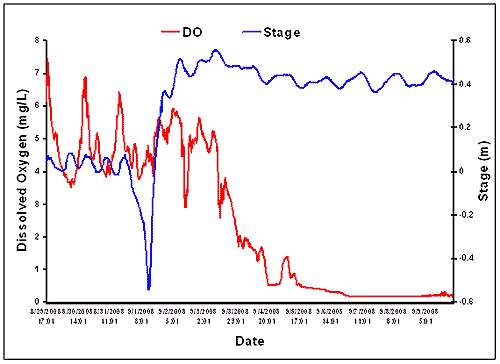| Hurricanes
Gustav and Ike left an unfortunate legacy in freshwater
systems across south and middle Louisiana: extensive fish
kills. Many of the systems that had just about recovered
from the 2005 hurricanes are again devoid of most fish.
These
hurricane fish kills are usually freshwater phenomena –
only rarely does a hurricane cause a salt-water kill and
then mostly in upper estuaries with considerable fresh-water
inflows. The primary culprit is the organic muck that characterizes
the substrates of most of Louisiana’s inland waters,
and the dissolved oxygen depletion that follows when violent
weather stirs it up.
Nearest
the coast, freshwater fish kills can occur from storm-pushed
saltwater intrusion. Most freshwater fish can handle a little
salt water, but when a storm pushes open-Gulf salinities
into freshwater systems, kills can occur. However, this
is a relatively minor occurrence when compared to the massive
kills that stem from post-storm oxygen depletion in waters
as far as 100 miles inland.
During
Gustav, an exceptional opportunity to observe storm effects
was afforded by some LSU research. Chris Bonvillain and
Jonathan West are graduate students in the School of Renewable
Natural Resources. In their work in the Atchafalaya Basin,
they were able to leave a continuously-recording instrument
in a bayou near Flat Lake in the southern basin. The instrument
recorded the dissolved oxygen (D.O.) concentrations and
water levels (stage) as Gustav passed almost directly over
it. In the chart below you can see the normal daily D.O.
cycle (red line) in the days before the storm. Highest D.O.
is late afternoon, when algae have produced oxygen, and
lowest is pre-dawn, when D.O. supply is depleted by (mostly
bacterial) respiration. The general downward trend is probably
due to increasing cloudiness.
The
blue line describes the stage, or water level. The sudden
drop of two feet during the morning of Sept. 1 is likely
associated with the arrival of 100+ mph north winds. Later
in the day, as the wind shifted to the south, the water
returned forcefully to higher-than- normal levels.
D.O.
began a downward trend after the storm, with a precipitous
drop two days after the storm. A number of factors were
undoubtedly at work: cloudy weather and murky water will
reduce D.O. Tons of leaves and debris were also blown into
the water and began to decompose. But the biggest factor
is probably the breakdown of the organic substrates that
had been thoroughly suspended throughout the water. This
is what produces the foul sewage/swamp smell from these
waters after a hurricane.
D.O.
reached critical concentrations late on Sept. 3, when concentrations
fell below 2 mg/l. By Sept. 6, D.O. readings were so low
that the instrument was essentially reading “zero”
for several days. D.O. that low, for that long, requires
overwhelming conditions. Some species of fish, such as shad,
will start dying at around 2 mg/l D.O. Larger specimens
of many species will succumb next, as their metabolic demands
are high and respiratory efficiency tends to be reduced.
After several days of 0 mg/l, even the toughest species
(like gar, which can supplement oxygen intake by gulping
air) are in trouble.

Back
to Top |